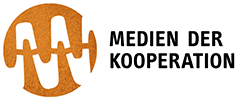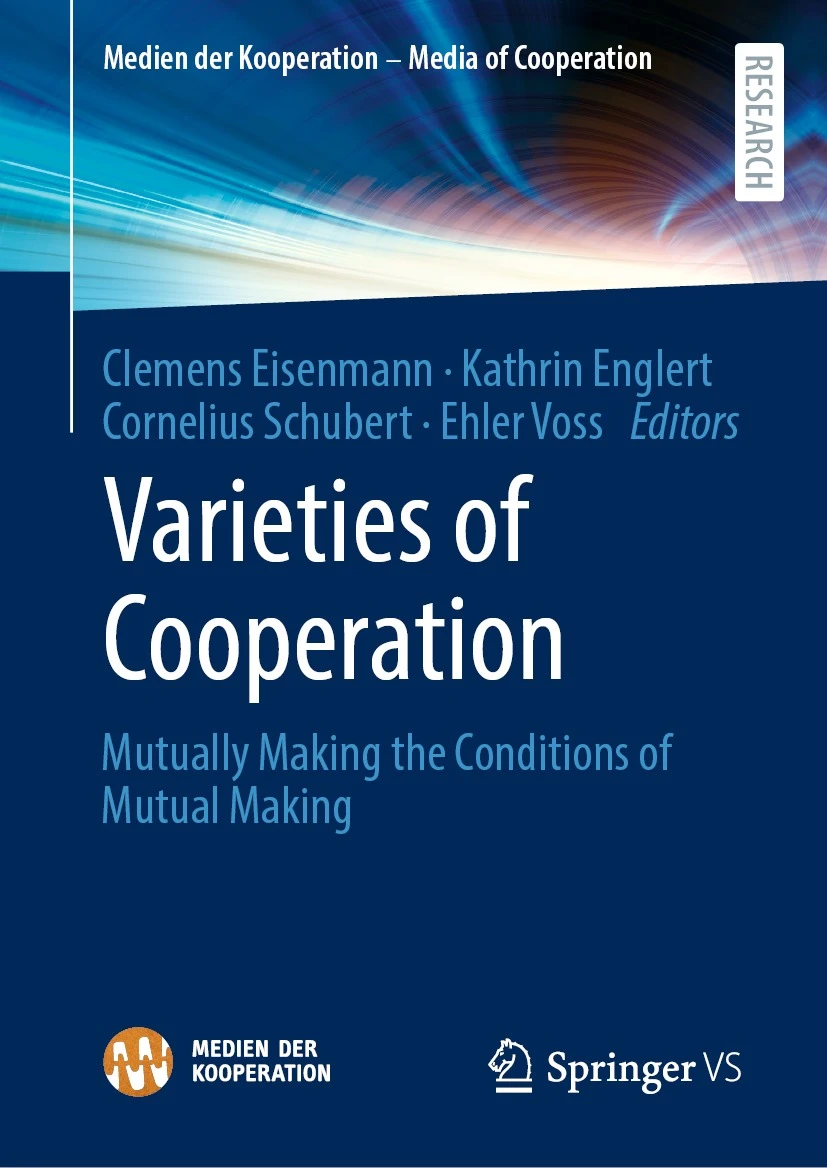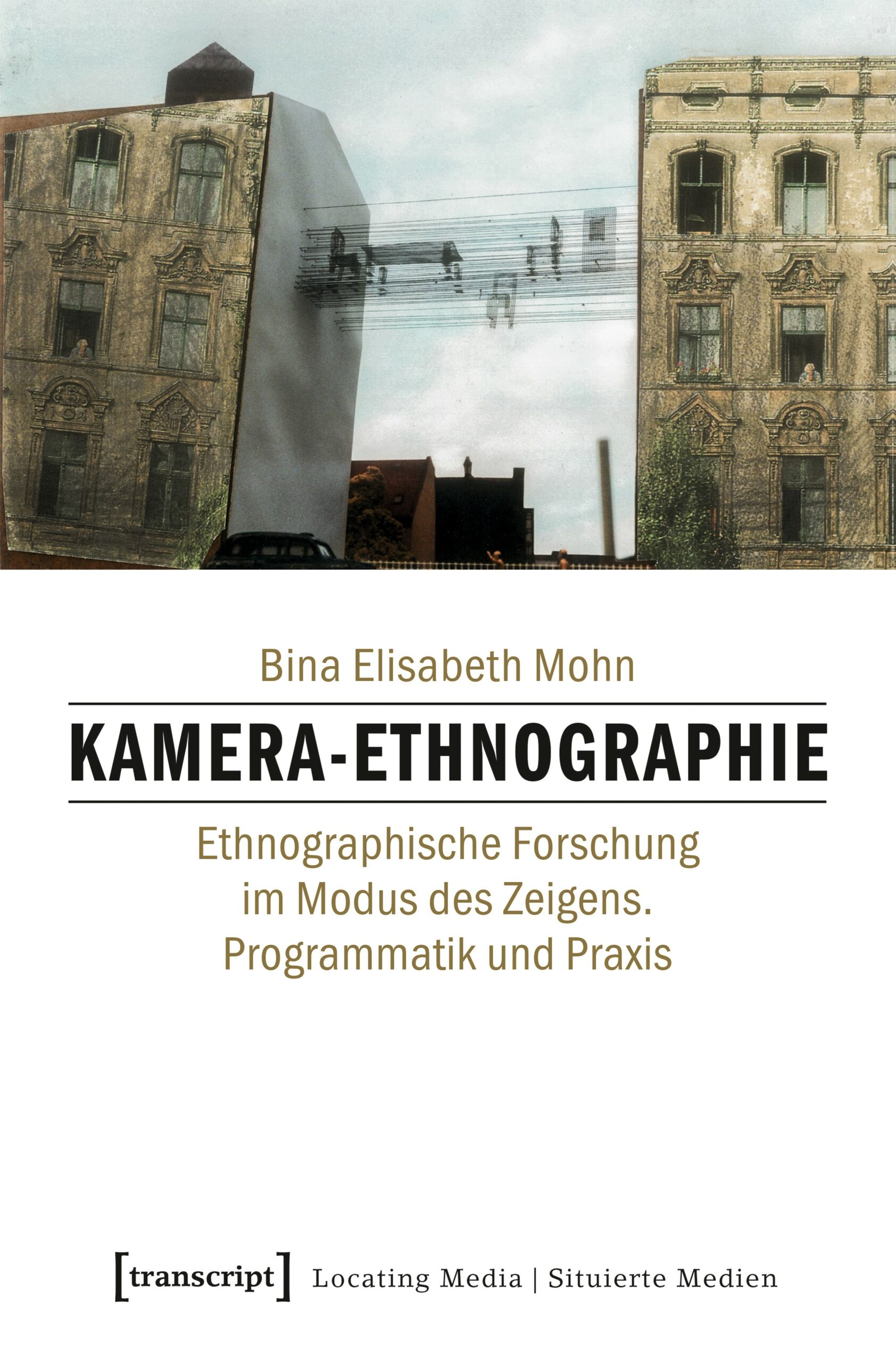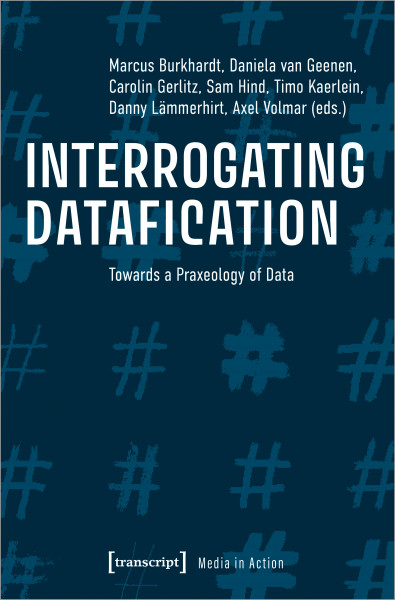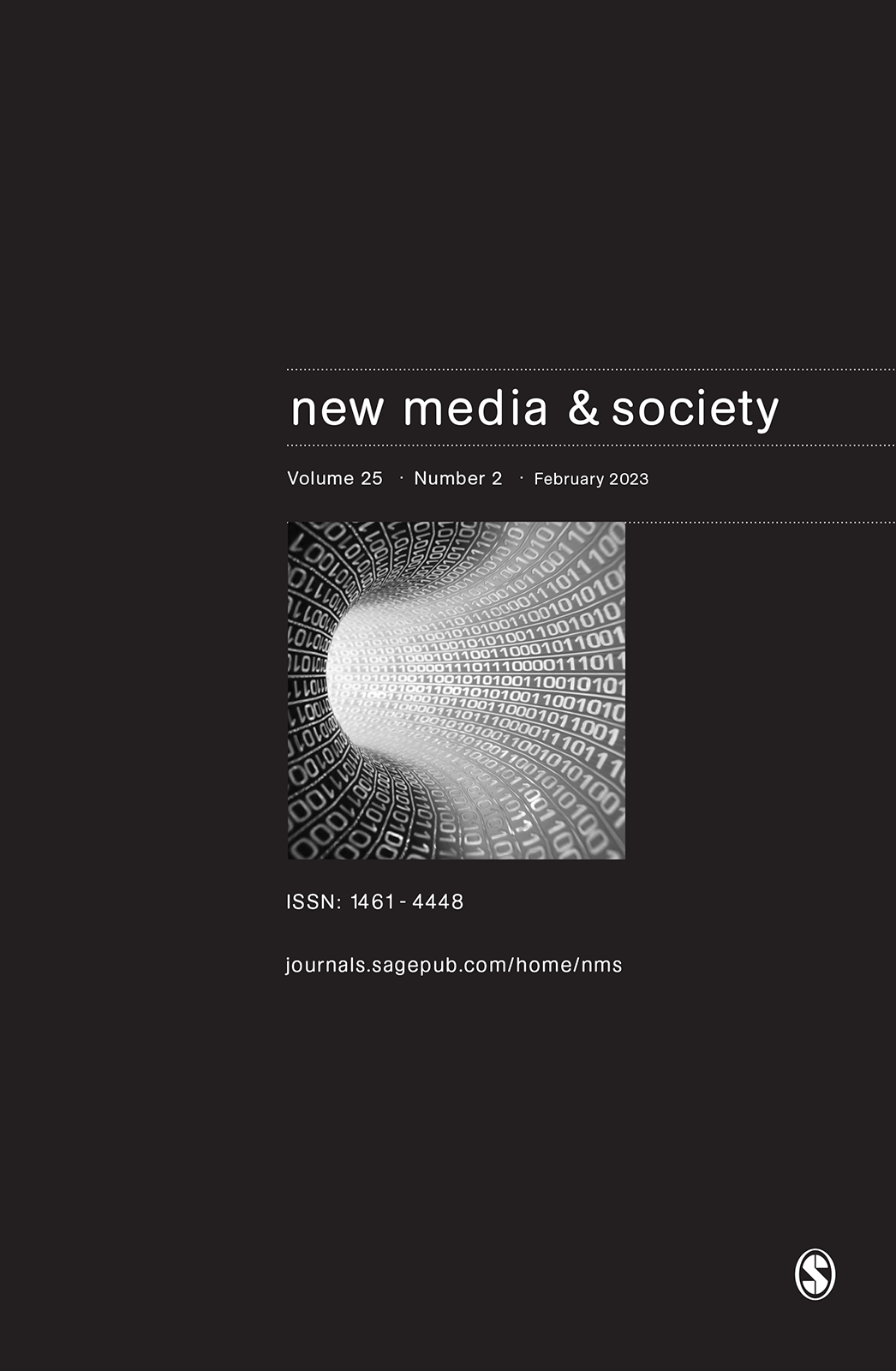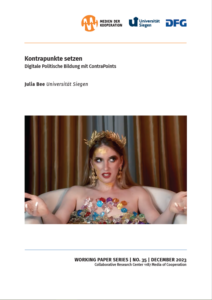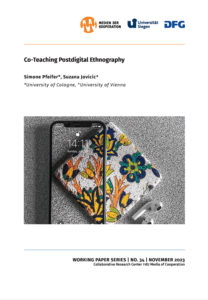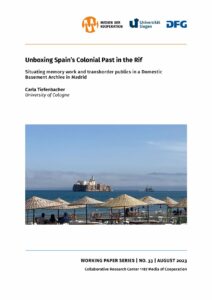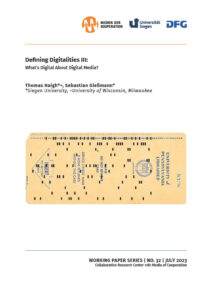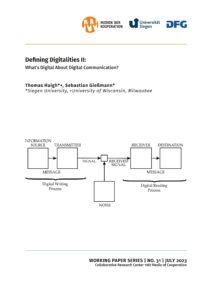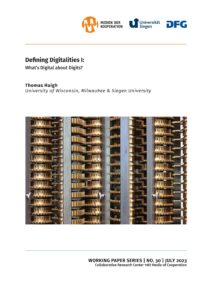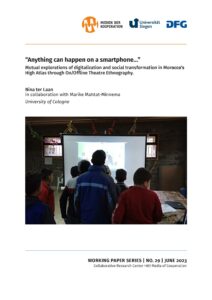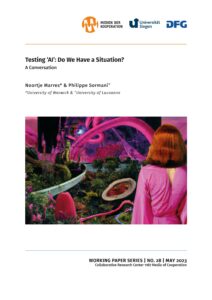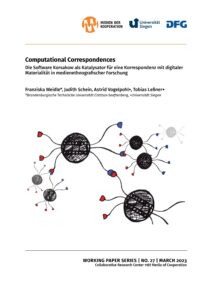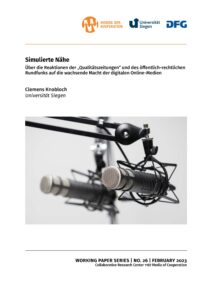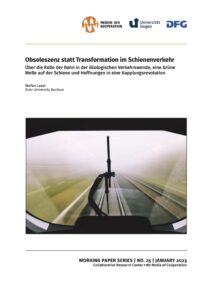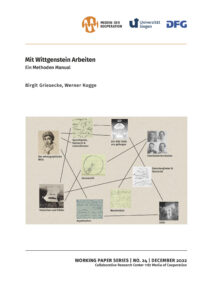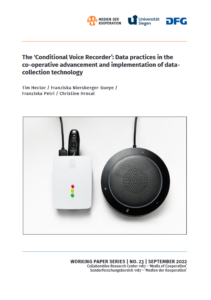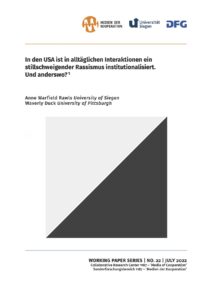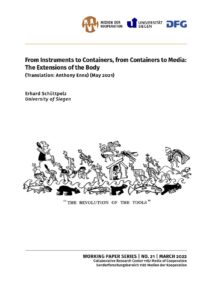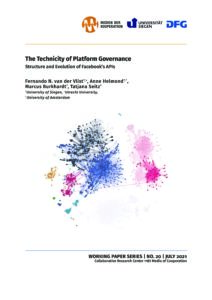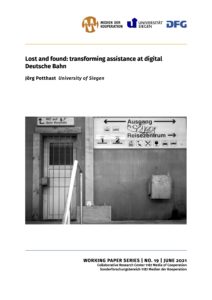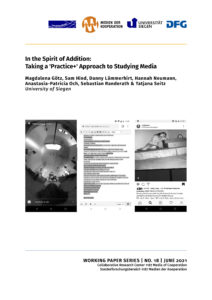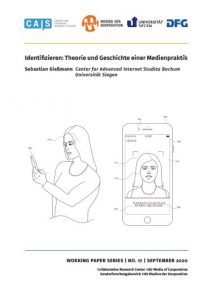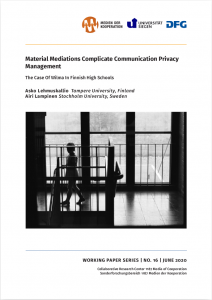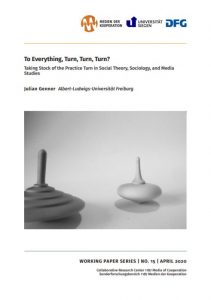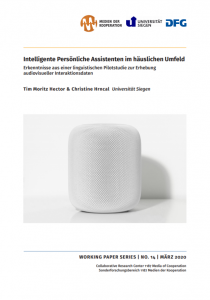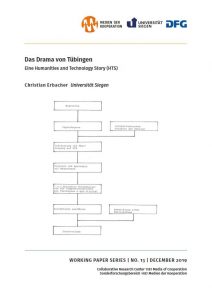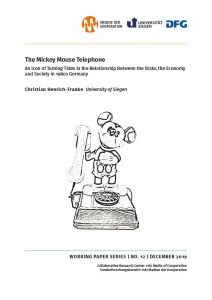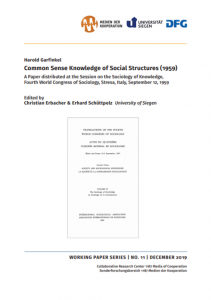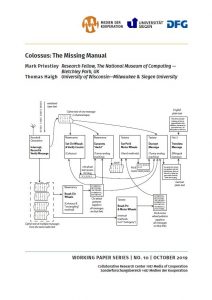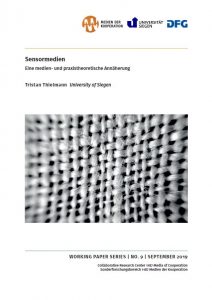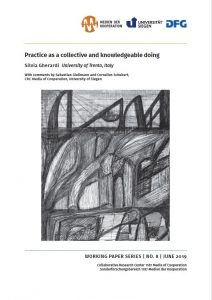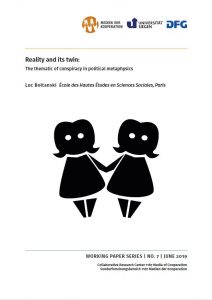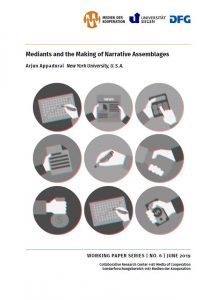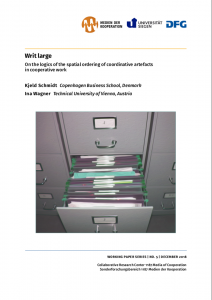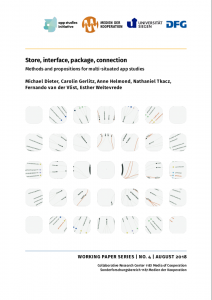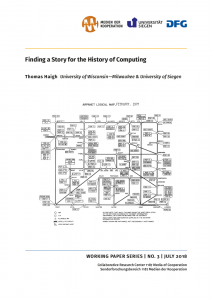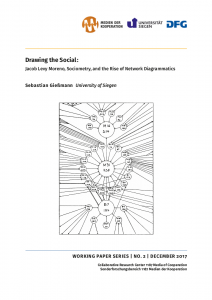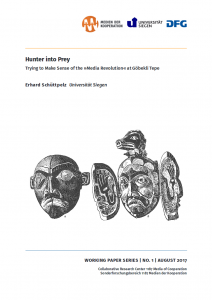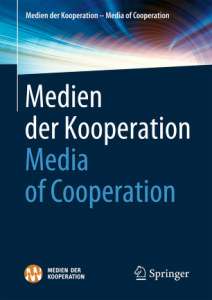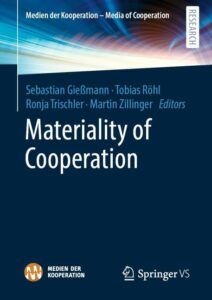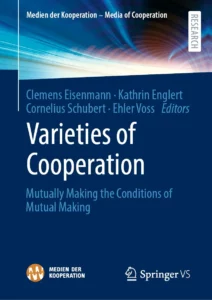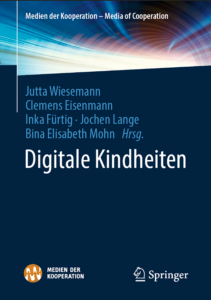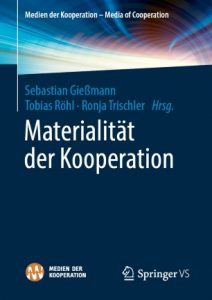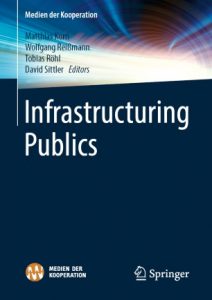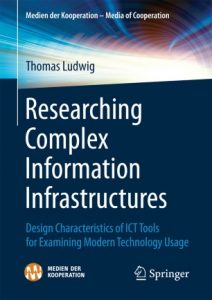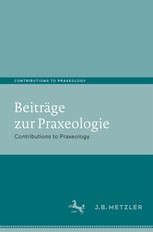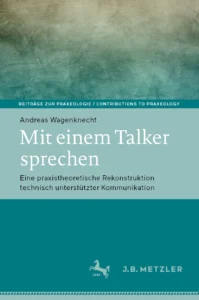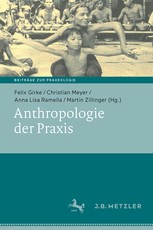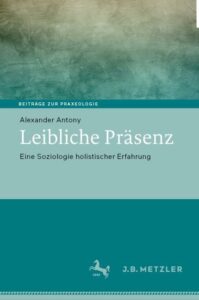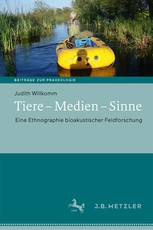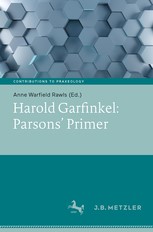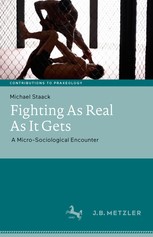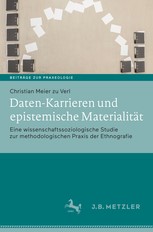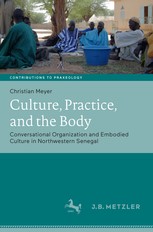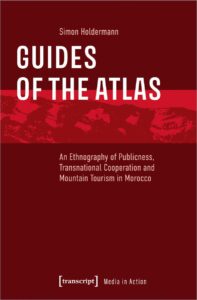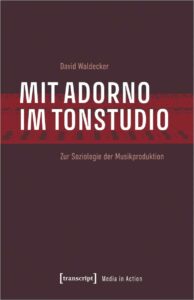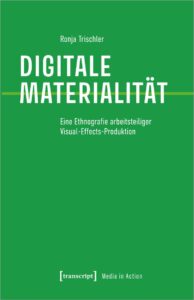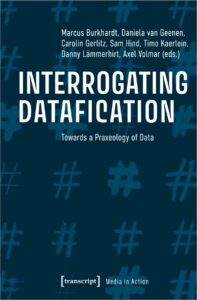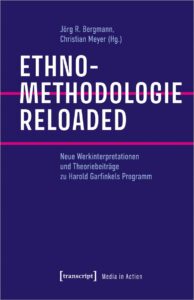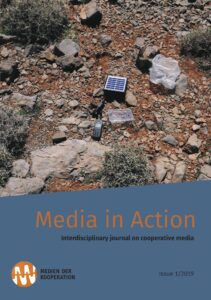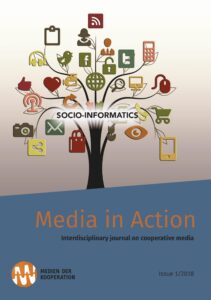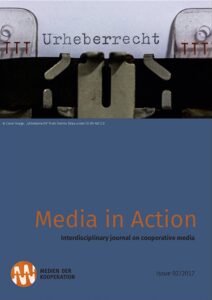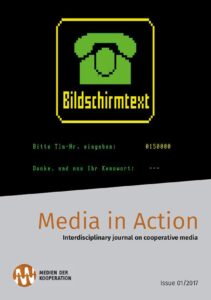The Working Paper Series of the Collaborative Research Center 1187 „Media of Cooperation“ promotes inter- and transdisciplinary media research. The CRC Working Paper Series provides an avenue for rapid publication and dissemination of ongoing research at or associated with the CRC. The Working Paper Series aims to circulate in-progress research to the wider research community beyond the CRC. Publication in the Working Paper Series does not preclude publication of a more developed version of the same paper in another journal. Contributions from established academics and postdoctoral researchers are welcome. The articles are published in open access and a limited number of print copies. We ask interested parties to send a paper proposal (max. 300 words) and a short biographical note (max. 50 words). Please follow our style guide for manuscript submission.
Funded by the German Research Foundation (DFG) – Project number 262513311 – SFB 1187 Media of Cooperation.
Series’ editor: Karina Kirsten, University of Siegen & CRC 1187 Media of Cooperation
contact: karina.kirsten[æt]uni-siegen.de
No 35 (2023) “Kontrapunkte setzen. Digitale Politische Bildung mit ContraPoints”
This text explores the potential of creative civic education formats in digital contexts. Foundations, institutions and vloggers have created new civic education formats in recent years in light of the shift to the right on platforms. These aim to prevent and intervene in right-wing discourse, trolling, fake news and the like. Informal formats of political education in the field of gender and queer studies are discussed on the basis of the YouTube channel ContraPoints. These are video essayistic counter-formats that aim to expose and recognize right-wing meta-politics. They produce educational formats that not only address content and information, but also aesthetics and affect. This text focuses on the format-specific nature of ContraPoints’ political education, which, following Donna Haraway, is understood here as situated knowledge.
No 34 (2023) “Co-Teaching Post-digital Ethnography”
Finding innovative, engaging, hierarchy-defying and, above all, precise descriptions of teaching exercises suitable for imparting complex theory and methodological approaches as multi-layered as postdigital ethnography is rare to find. Those that exist are mostly scattered across a few non-specific blogs and private Twitter feeds – finding them is a matter of an obscure combination of serendipity and algorithms. In this working paper we reflect on our co-teaching methods applied in a Masterclass on postdigital ethnography. Our aim is twofold: not only to reflect on teaching methods in postdigital ethnography, but also to present concrete examples of implementation in teaching and co-teaching constellations by means of teaching exercises.
No 33 (2023) “Unboxing Spain’s Colonial Past in the Rif Situating memory work and transborder publics in a Domestic Basement Archive in Madrid”
In the Northern Moroccan city of Al Hoceima, Spanish and Moroccan history of the 20th and twenty-first century converge. The protracted anti-/colonial war fought between parties from both territories gave rise to the bloody Spanish Civil War and Francoist dictatorship and formed a basis for post-independence military oppression in the Rif uprisings 1958/59. A growing body of ethnographic work focuses on memory work on both topics in this area from Moroccan perspectives and with eyes on oppressed subjects (Aixelà-Cabré 2022, Nahhass 2022). Drawing on recent work on ‘implicated subjects’ (Rothberg 2019), I argue that it is also necessary to consider ongoing trans-Mediterranean and Spanish memory activism in order to fully understand the workings and duress of colonialism in Spain and Northern Morocco. To that end, the following paper analyzes archival practices about colonial Alhucemas and postcolonial Hoceima surrounding one private collection among this last generation of Spanish colonizers. It builds on fieldwork I conducted among former Spanish residents of Al Hoceima. As children and young adults, they grew up in relative colonial freedom under the totalitarian Franco regime. As adults, they witnessed two transitions: the transition to Moroccan independence 1956 and the transition to Spanish democracy from 1978 onwards, and many of them engage in collecting practices surrounding these transitions. This paper outlines how objects circulate in and out of one of their archives and how publics congregate around them. Through the objects, Former Residents, Spanish institutions, Spanish and Riffian actors become actors and publics who enter in relationships of co-operation without consensus about a shared narrative of perpetrators, victims and history at large. Three contested issues are made to travel through the analyzed collection: a continuously invoked notion of convivencia, (architectural) traces of a colonial past in the Hoceima cityscape and administrative and social secrets of mutual surveillance. I am interested in how these issues form part of a boundary infrastructure of memory work between Spain and Hoceima (Star and Griesemer 1989, Star and Bowker 2017, Schubert 2017). This working paper will serve as an intermediary step to explore competing and shared notions of victimhood, forms of co-operation and the creation of transborder publics around the entangled histories of life on both shores of the Mediterranean.
No 32 (2023) “Defining Digitalities III: What’s Digital About Digital Media?”
In this working paper we explore an alternative thread in the early development of media and medium as concepts: the origins of the idea of the storage medium in digital computing practices and communities of the 1940s and 1950s. While such practices were obscure at the time, they laid the technological foundation for today’s range of digital media. We discuss digitality as a feature of the practices used to read and write symbols from a medium, not a physical property of the medium itself. We then move on to a discussion of the alphabet as itself digital, grounded in the work of Nelson Goodman. Engaging with the contributions of Matthew Kirschenbaum, we explore the limited interchangeability of representations between different encodings of the same symbols, connecting the purported immateriality of digitality to this actual fungibility of material representations.
No 31 (2023) “Defining Digitalities II: What’s Digital About Digital Communication?”
Although the distinction between digital and analog was first made in the context of automatic computers, the concepts were quickly broadened to apply to media and communication systems of all kinds. This working paper continues work on both fronts by looking at the historical broadening of the concept of digitality to include non-numerical systems of representation such as those used to encode text and pictures. This conception underlies the ability of computers to deal with things other than numbers, but it has its roots in communications theory, most famously in the work of Claude Shannon. In parallel with our historical description of the emergence of nonnumerical conceptions of digitality we broaden our analytical treatment of digitality to encompass more historical technologies and reading practices: not only adding machines and punched cards, but also musical boxes, weaving systems, movable type, and even alphabets and hand gestures.
No 30 (2023) “Defining Digitalities I: What’s Digital about Digits?”
Modern discourses emphasizes electronic immateriality as the defining feature of digital technology. The idea that digits might be digital when punched onto cards, or even written on a piece of paper, is no longer intuitive. Yet by reconstructing the context in which the categories of digital and analog were first distinguished historically in the 1940s, I argue that the concept of digitality is rooted in the mechanical representation of digits in early computers, which contemporary observers immediately recognized was shared with earlier technologies such as telephone switching systems, punched cards, and calculating devices. Digitality is not a feature of an object itself, but of the way that object is read (whether by human or by machine) as encoding symbols chosen from a finite set. In conclusion, digitality is constituted through reading practices.
No 29 (2023) “‘Anything can happen on a smartphone…’ – Mutual explorations of digitalization and social transformation in Morocco’s High Atlas through On/Offline Theatre Ethnography“
This paper discusses the use of (online) theatre as an ethnographic research tool in an existing collaborative study on (digital) media use and social transformation in a Moroccan village situated in the High Atlas Mountains of Morocco. Due to the challenges posed by the Covid-19 pandemic to the ongoing fieldwork there, the project team sought a way to re-establish a regular feedback loop with the village community in a non-phys–ical way. As a solution, the project team, together with the local partners, decided to bring in a theatre maker to conduct online theatre workshops, with the aim to bring the project back to life in a meaningful way and to generate data for the overall goal of the project: to explore and develop socio-technical collabora–tion infrastructures in Morocco. This working paper describes the process, motivations, design, and outcomes of the project, as well as the controversies, opportunities, and struggles that arose during the theatre work. It also reflects on the added value and objections of such a collaboration between an academic and an artistic discipline and describes the process of ‘negotiating con–nection’ between researchers and research partners amidst the pandemic. I argue that, despite the necessary challenges, using theatre as a methodological tool for ethnographic research, can, through cooperation, allow researchers to better understand cultural practices, social relations, and power dynamics within a marginalized community.
No 28 (2023) “Testing ‘AI’: Do We Have a Situation? – A Conversation”
This working paper is based on the transcription of a recent conversation between the authors, regarding current instances of the real-world testing of “AI” and the “situations” they have given rise to, or as the case may be, not. The conversation took place online, on the 25th of May 2022, as part of the Lecture Series Testing Infrastructures, organized by the Special Collaborative Research Center (CRC) 1187 “Media of Cooperation” at the University of Siegen, Germany. This working paper is an elaborated version of this conversation and is organised as follows. The introduction presents an expanded version of the lecture abstract, which was used to advertise the online conversation. The bulk of the working paper reproduces and extends the transcribed conversation, as well as parts of the ensuing discussion with the audience. In the conclusion, we address the question “do we have a situation?,” when it comes to AI testing in society, in the light of the conversation, and reflect on “what’s next” in social studies of “AI” testing situations, as well as on turntaking in (online) conversation.
No 27 (2023) “Computational Correspondences – Die Software Korsakow als Katalysator für eine Korrespondenz mit digitaler Materialität in medienethnografischer Forschung”
Das Working Paper stellt die vorläufigen Ergebnisse einer Meisterklasse für Medienethnographie dar, die im April 2022 an der Universität Siegen stattgefunden hat und vom SFB 1187 „Medien der Kooperation“ ausgerichtet wurde. Zentral war dabei die Fragestellung, welche Forschungspraktiken entstehen, wenn Ethnograph:innen die digitale Materialität ihrer Forschungsgegenstände, -instrumente und -umgebungen als aktive Partizipient:innen innerhalb des Forschungsprozesses begreifen. Eine Annäherung an solch eine bewusste „Korrespondenz“ mit digitaler Materialität (Weidle 2020) wurde über die Autorensoftware Korsakow initiiert. Das Besondere an Korsakow ist die computergenerierte multilineare Verkettung einzelner Mediendateien. Durch die Arbeit mit Korsakow sollten mögliche neue Zugänge an das eigene Forschungsmaterial exploriert und kritisch diskutiert werden. Exemplarisch stellen zwei Teilnehmer:innen der Meisterklasse ihre Erkenntnisse aus dieser Auseinandersetzung vor. Astrid Vogelpohl betrachtet Korsakow dabei als eine Variante kombinierenden visuellen Forschens, in der Algorithmen als nichtmenschliche Forschungspartner:innen den Analyseprozess unterstützen. Inwieweit sich dabei die Forschungswege von einer Analysearbeit mit vornehmlich menschlichen Partner:innen unterscheiden, steht im Zentrum ihrer Ausführungen. Tobias Leßner hingegen beschreibt zunächst seinen persönlichen Zugang zu Korsakow sowie die damit einhergehenden Irritationen, Fragen und Überlegungen vor dem Hintergrund seiner ethnographischen Arbeit zu demokratischen Schulen und deren Darstellung mittels Virtual Reality. Daran anschließend fokussiert er, was sich für pragmatische aber auch methodologische Implikationen aus der Verschiebung der Autor:innenschaft des/der Ethnograph:in in Richtung Algorithmus und der Interpretationsmacht in Richtung der Rezipient:innen ergeben. Letztlich sind die vorgestellten Ansätze Ausgangspunkte für weitere Suchbewegungen nach dem Digitalen und seinem (Mit-)Wirken in einer (medien-)ethnographischen Forschungsarbeit, die sich im Sinne des ontologischen Turns diffraktiv rekonfiguriert (Mellander/Wiszmeg 2016). Als Teil der Wissensproduktion geht es dabei auch darum, wie sich die Korrespondenz mit digitaler Materialität in die Vermittlung wissenschaftlicher Ergebnisse einschreibt und transparent gemacht werden kann.
No 26 (2023) “Simulierte Nähe – Über die Reaktionen der „Qualitätszeitungen“ und des öffentlich-rechtlichen Rundfunks auf die wachsende Macht der digitalen Online-Medien”
Ausgehend von einem Gutachten, das die Kognitionswissenschaftlerin Elisabeth Wehling im Auftrag der ARD 2019 erstellt hat, und das den Anstalten der ARD empfiehlt, ihr angeschlagenes öffentliches Image dadurch zu verbessern, dass sie in allen Verlautbarungen ihre moralische Gemeinschaft mit dem Publikum rhetorisch herausstellen, geht der Text der These nach, dass der öffentlich-rechtliche Rundfunk und die sogenannten Qualitätsmedien sich ohnehin per simulierter Nähe den Kommunikationsbedingungen der Digitalmedien und sozialen Netzwerke anpassen. Diesen letzteren gegenüber versuchen sie aber, ein Tatsachenmonopol für sich zu errichten.
No 25 (2023) “Obsoleszenz statt Transformation im Schienenverkehr – Über die Rolle der Bahn in der ökologischen Verkehrswende, eine Grüne Welle auf der Schiene und Hoffnungen in eine Kupplungsrevolution”
Climate change and environmental issues call for an ecological transformation of production and consumption. In Germany, the transport sector is considered the “troubled child” of the transformation, because emissions in the mobility sector have not fallen in recent decades, in contrast to other sectors. But there are signs of change – the car industry has been criticised since the “diesel scandal” and, alongside electric mobility, e-fuels and cycling, the rail industry is seen as a beacon of hope. The industry emphasises its importance for climate and ecology and can thus establish a stable new reference in the public.
Yet the situation is ambivalent. To better understand this dynamic, the first part of this article works through the transport transition discourse with a focus on rail transport. Extensive data from the social media platform Twitter serve as a basis. This part gives an overview of the actors involved and their positions and shows competing understandings of the transport transition as well as the multiplicity of problem ideas. From a qualitative perspective, the second part discusses two innovative projects in rail transport: the “Green Function of Movement Control”, which brings a kind of green wave to rail, and the “Digital Automatic Coupling”, which is intended to replace a coupling technology in freight transport that is more than 150 years old. However, it becomes apparent that the ecological transformation at the workplace rail is fleeting. The railways themselves are not driving any transformation, because they are instead preoccupied with issues of obsolescence – i.e. issues of ageing – i.e. with repair, maintenance, servicing as well as old technology and entrenched, slowly grown administration. This is not a problem per se, but an adequate description of the work and competences that are necessary to keep a rail network alive – and that need to be appreciated. If there is to be a change in transport by and with the railways, it will only work with less and slower traffic, also on the railways.
No 24 (2022) “Mit Wittgenstein Arbeiten – Ein Methoden Manual”
Das Manual bietet in Form von 10 Einsätzen einen Zugang zur Methodologie in den mittleren Schriften und im Spätwerk Ludwig Wittgenstein. Sowohl Hintergründe, Zitate im Kontext, als auch weiterreichende Fragen und Hinweise werden übersichtlich präsentiert. Dadurch wird eine erste Orientierung hinsichtlich der wesentlichen Eckpunkte einer praxeologisch orientierten Sprachphilosophie ermöglicht. Zentrale Theoreme wie grammatische Untersuchung, Beschreibung, Sprachspiel, Familienähnlichkeit werden vertiefend und in ihrem gedanklichen Zusammenhang dargestellt. In seiner überblickshaften Darstellung zielt dieses Manual auf ein theoretisches und praktisches Verständnis der Philosophie Wittgensteins als Arbeitsform und damit auf eine Erschließung dieser Philosophie als eine ebenso praktikable wie durchgreifende Vorgehensweise im Spektrum wissenschaftlich-kritischer Methodologien
No 23 (2022) “The ‘Conditional Voice Recorder’: Data practices in the co-operative advancement and implementation of data-collection technology“
Stationary voice-controlled systems are installed in an increasing number of households. The devices are operated primarily via voice-user interfaces, which evaluate the spoken commands cloud-based, and are aligned to the principles of interpersonal interaction. This raises questions about the integration of the devices into everyday practices carried out in the household: How is use of smart speakers negotiated situationally, embedded in interpersonal interactions, and (how) are aspects of data privacy, data processing and potential exploitation reflected by the users? The project “Un/desired Observation in Interaction: Intelligent Personal Assistants” in the CRC “Media of Cooperation” approaches these questions empirically. However, such an investigation of smart speakers faces the methodologi-cal challenge that this requires voice data documenting not only the use of the smart speaker itself, but also the contexts of the use that go beyond mere “voice commands”. Therefore, a “Conditional Voice Recorder” (CVR), a technology developed in Nottingham by Porcheron and colleagues (2018), was brought to bear to create audio recordings of usage contexts. These include not only the voice command itself, but also a few minutes before and after the smart speaker is addressed. However, the original device required further technical development to be compatible not only with Amazon’s smart speaker model, but also products from other providers (Google and Apple). The paper reflects on this advancement and the implementation of the CVR i.e. our own research practices as data practices. On the one hand, it makes visible which (otherwise opaque) data were collected and processed during the advancement, how the usage of the CVR itself is inscribed in the data recorded with it, and which data practices were carried out in the evaluation. On the other hand, it documents the advancement and application of the CVR to enable other studies with it (or similar technologies).
No 22 (2022) “In den USA ist in alltäglichen Interaktionen ein stillschweigender Rassismus institutionalisiert. Und anderswo?”
In unserem Buch Tacit Racism („Stillschweigender Rassismus“) zeigen wir, dass Rassismus in den Vereinigten Staaten in die „alltäglichen“ Erwartungen an zwischenmenschliche Interaktionen eingeschrieben ist. Dafür gehen wir der Frage nach, wie es auf einer sozialen Ebene, die wir als „Interaktionsordnung von race“ (Interaction Orders of Race) bezeichnen, zur ständigen Produktion und Reproduktion von unbewusstem Rassismus kommt, der sich im Alltag auf „stillschweigende“ und unhinterfragte Weise bemerkbar macht. In den USA sind soziale Konstruktionen von race spätestens seit dem 16. Jahrhundert die wichtigste Kategorie bei der Herstellung der sozialen, professionellen und bürgerschaftlichen Ordnung in den USA, bis heute sind sie tief in den Strukturen sowohl des formalen Rechts als auch informeller Praktiken verankert. In unserem Buch beschreiben wir, wie Menschen in der Begegnung mit anderen kontinuierlich und unbewusst auf eine Reihe von Erwartungen zurückgreifen, die unser Handeln bestimmen und anleiten. Da diese Erwartungen und Voreinstellungen durch einen über Jahrhunderte gewachsenen systemischen Rassismus geprägt sind, sehen wir uns permanent dazu veranlasst, auf der Grundlage rassistischer Vorurteile zu agieren, die unser gesamtes Handeln beeinflussen können: von der Art, wir wir unsere Nachbarn begrüßen, bis hin etwa zur Frage, ob wir einen zweiten Blick auf einen bestimmten Lebenslauf werfen. Bei dem „stillschweigenden Rassismus“, so unsere These, handelt es sich um eine der sich am schnellsten ausbreitenden und gefährlichsten Bedrohungen für die Zukunft der Demokratie. Wir gehen davon aus, dass die US-amerikanische Entwicklung eines binären kategorialen Schemas, das sich an der strikten Opposition von Schwarz und Weiß orientiert, in gewisser Weise singulär ist. Mit der Absicht, Forschungen und Ansätze zu race auch in anderen Ländern zu bereichern, fragen wir in dem Sonderheft der Zeitschrift für Kulturwissenschaften 2/2021 darüber hinaus, ob und inwiefern sich auch in anderen Ländern Elemente eines „stillschweigenden Rassismus“ finden lassen. Dabei argumentieren wir, dass die spezifischen Bedingungen, die in den Vereinigten Staaten zur Herausbildung eines binären Systems der Rassen geführt haben, zwar ganz andere sind als in Europa, die US-amerikanische Praxis und Konstruktion von race jedoch in die ganze Welt exportiert wurde, wodurch auch in anderen Gesellschaften die tiefe Verankerung von „stillschweigendem Rassismus“ verschärft werden konnte.
No 21 (2021) “From Instruments to Containers, from Containers to Media: The Extensions of the Body“
There is a long tradition of conceptualising the ‘extensions of man’ or the ‘extensions of the body’ as devices enabling the emergence of technical instruments and/or of media, a tradition renewed by recent discussions in German media studies (Siegert, Harrasser, Kassung). But most of the earlier protagonists of this tradition focussed exclusively on the extensions of human extremities and the brain (McLuhan, Leroi-Gourhan, Kapp). Only a minor tradition mentioned ‘containers’ as technical and figurative externalisations of the rump and of whole bodies (Mumford). Especially the British archeologist Clive Gamble has recently pointed to a long ‘drift’ from instruments to containers, and to the ambiguities of technical and figurative containers. Gamble’s renewal of Mumford’s intuition gives media theory a unique chance to develop a new prehistory of today’s media and computer interfaces: acknowleding the long-term impact of gender divisions of labour; completing the incomplete matrix of Leroi-Gourhan’s technical extensions by pondering the distributed cognition of traps and work-places; elucidating the spatial intelligence of useful, ritual and aesthetic skills; explicating the cooperative spatial action enabled by media such as maps and cosmograms, Amerindian bundles, Sub-Saharan masks and Siberian drums and many others yet to be explored in the long drift from instruments to containers to media.
No 20 (2021) “The Technicity of Platform Governance: Structure and Evolution of Facebook’s APIs”
Researchers, policymakers, and competition and regulation authorities worldwide recognise application programming interfaces (APIs) for powering the digital economy and driving processes of datafication and platformisation. However, it is unclear how APIs tie into the power of, and governance by, large digital platforms. This article traces the relationality between Facebook’s APIs, platform governance, and data strategy based on an empirical and evolutionary analysis. It examines a large corpus of (archived) developer pages and API reference documentation to determine the technicity of platform governance – the technical dimension and dynamics of how and what platforms like Facebook seek to govern. It traces how Facebook Platform evolved into a complex layered and interconnected governance arrangement, wherein technical API specifications serve to enforce (changes to) platform policy and (data) strategy. Finally, the article discusses the significance of this technicity in specifying the material conditions for app and business development ‘on top of’ platforms and for maintaining infrastructural and evolutive power over their ecosystems.
No 19 (2021) “Lost and found: transforming assistance at digital Deutsche Bahn”
Paying close attention to the intricacies of the episode below, this paper sets out to reflect in situ a shift to digitizing “lost and found” services. Foreshadowing a more extensive study on a contemporary redistribution of assistance at Deutsche Bahn, it refers to a pragmatist tradition concerned with preserving the condition of voice. Following this vein, it faces a purist critical attitude – epitomized in the practice of economics (Orléan 2014), which defends market forces (“exit”) as a way to outperform voice in any situation of decline, decay or dissatisfaction (Hirschman 1970). Anti-elitist suspicions, brought to perfection by another branch of social sciences, have become a powerful ally of this position. Rather than criticizing elitism and privilege, however, the present contribution draws on ethnographic research which displays the ambiguity of privileged users’ encounters with assis- tants. Exploring ambiguous patterns in the practice of assistance, it seeks for a politics of pity which has been largely absent from current appraisals of digital sociality.
No 18 (2021) “In the Spirit of Addition: Taking a ‘Practice + Approach’ to Studying Media”
This collection of articles considers the possibility of taking an “additive” approach to studying media, which the contributors to the collection refer to as a “practice + approach”. In this spirit the collection attempts to establish novel connections that potentially bring new life to the study of practice, by exploring new concepts, thinkers, energies, methodologies, and disciplinary traditions. These additional engagements, it is argued, are intended to augment and supplement (rather than displace or replace) popular practice approaches offered through, and found within, ethnomethodology, organizational studies, workplace studies and similar. The articles explore how practices are variously constituted in, and through, contemporary media such as video platforms, collaborative text editors, enterprise software, social media APIs, automotive navigation systems, and health data apps. In these cases not only does one find a welter of varied, interconnected, multiscalar, differentially located practices but in the process of their articulation, one also discovers new vocabularies with which to document and articulate them. The contributions, thus, gesture towards how relations between media and their practices can be alternatively and fruitfully approached, evidencing new lines of thinking and doing in the study of practice.
No 17 (2020) Sebastian Gießmann: Identifizieren: Theorie und Geschichte einer Medienpraktik
Registrieren, Identifizieren und Klassifizieren sind Praktiken, die in digitalen Kulturen kaum mehr zu trennen sind. Anhand der Mediengeschichte des Passes und der Kreditkarte geht der folgende Text der Frage nach, wie immer neue infrastrukturelle Kaskaden des Identifizierens entstehen und welche öffentliche Brisanz den entsprechenden Datenverarbeitungen innewohnt. Beim Identifizieren handelt es sich um eine kooperative Medien- und Datenpraktik, an der stets mehr als eine Person beteiligt ist. Sie involviert von Anfang an menschliche Körper samt ihrer semiotischen Ressourcen und koppelt diese mit bürokratischen Aufschreibesystemen. Auch die neuesten digitalen Prozeduren greifen bevorzugt auf Gesichter und Fingerabdrücke zu: Biometrie versucht, den für das Identifizieren konstitutiven Abstand zwischen Konten, Körpern und Personen aufzuheben.
No 16 (2020) Asko Lehmuskallio & Airi Lampinen: Material Mediations Complicate Communication Privacy Management
Increasingly, school settings are implementing digital technologies to coordinate teachers’ work. The article examines the role of these technologies in teachers’ boundary regulation processes through the lens of communication privacy management theory, and it provides empirical insight into the renegotiation of being a teacher in the presence of rules formalized in software code. The case of Finnish high school teachers exposed to the use of Wilma, a distributed computing system used to store, process, and transmit student data, revealed experiences of a need to renegotiate formalized and trackable work processes, faster and more colloquial communication, and intensified day-to-day work. These influence modes of accountability and the need to negotiate visibility, along with understandings of rules as a central coordination mechanism for interpersonal boundary regulation. The authors suggest in addition that these technologies inure various social stakeholders to constant technical monitoring and regular accounting, thereby advancing the normalization of surveillance practices. This creates good reason to pay closer attention to how rules of engagement may be coordinated.
No 15 (2020) Julian Genner: To Everything, Turn, Turn, Turn?
This article reviews the “practice turn” (PT) in sociology, social theory, and media studies. In addition, it develops a sociological perspective on turns in general. As other turns, PT presents itself as heterogeneous and interdisciplinary phenomenon lacking clear conceptual and institutional boundaries. In order to grasp this fuzziness inherent to PT, I regard PT as a “sign-post” (Wittgenstein 1984) giving rather vague directions and thus “assembling” (Latour 2005) a heterogeneous research community. Thus, my main question is as follows: How does PT guide research and how do researchers follow PT? Drawing on interviews with researchers involved in PT, I distinguish two major ideal-typical ways of following PT. Revolutionary approaches aim for overcoming existing ways of doing research by turning to practice. In contrast, reformative approaches aim for a renewal of disciplines. Whereas revolutionary approaches mainly arise in interdisciplinary fields and various “studies”, reformative approaches flourish on the margins of sociology. In exploring this pattern, the article develops a sociological way of reflecting PT and turns in general. Thereby the article establishes an institutional perspective drawing on the work of Boltanski and Chiapello (2007).
No 14 (2020) Tim Moritz Hector & Christine Hrncal: Intelligente Persönliche Assistenten im häuslichen Umfeld
Sprachassistenten werden in einer steigenden Zahl von Haushalten in den Alltag eingebunden. Es zeigen sich dabei sprachliche und kulturelle Praktiken, die durch die Integration artifizieller Mündlichkeit in die Interaktion entstehen, wie sie bisher noch nicht beschrieben werden konnten. Diese untersucht der gesprächslinguistisch ausgerichtete Teilbereich des Projekts B06 „Un/erbetene Beobachtung in Interaktion: ,Intelligente Persönliche Assistenten‘ (IPA)“ im Sonderforschungsbereich „Medien der Kooperation“ an der Universität Siegen. Sprachassistenzsysteme sind außerdem für ihre Funktionalität auf die dauerhafte Beobachtung des häuslichen Umfelds angewiesen. Die Reflexion der NutzerInnen über dieses „Mithören“, das im öffentlichen Diskurs teilweise sehr kritisch betrachtet wird, steht ebenfalls im Fokus der im Projekt durchgeführten Untersuchungen. Im Rahmen der hier vorgestellten Pilotstudie werden methodische Prämissen im Hinblick auf das Vorgehen bei der Datenerhebung reflektiert und aus den gewonnenen Daten erste Anhaltspunkte für die sprachwissenschaftlichen Analysekategorien herauskristallisiert. Der Schwerpunkt liegt dabei auf der Identifikation von sprachlich-interaktionalen Praktiken und deren Einbettung in soziokulturelle Praktiken, die in der Hauptstudie ebenfalls näher beleuchtet werden sollen. Unsere Daten zeigen, dass Interagierende ein Sprachassistenzsystem nicht wie einen zusätzlichen Gesprächsteilnehmer in die Interaktion einbeziehen, sondern es durchaus wie ein technisches Gerät behandeln. Gleichzeitig scheint die parallele Nutzung des medial mündlichen Kanals zur Bedienung eines Geräts auf der einen und zum Führen einer Konversation auf der anderen Seite Auswirkungen auf das Repertoire sprachlich-interaktionaler sowie kultureller Praktiken zu haben.
No 13 (2019) Christian Erbacher: Das Drama von Tübingen
Was geschah am Tübinger Wittgenstein Archiv? – Unter Wittgensteinforschern regt diese Frage seit mehr als 30 Jahren zu Spekulationen und Legendenbildung an. Das Archiv war das erste große Projekt zur Herstellung einer maschinenlesbaren Transkription von Ludwig Wittgensteins nachgelassenen philosophischen Schriften (ca. 20.000 Seiten) als Vorbereitung für eine wissenschaftliche Gesamtausgabe. Dieses Projekt begann mit großen Hoffnungen und versprach, eine Sternstunde sowohl für die philosophische Editorik als auch für die frühen Digital Humanities zu werden. Doch die Projektgruppe zerbrach alsbald. Bis heute sind die näheren Umstände des Zusammenbruchs nicht bekannt. Daher stellt dieser Beitrag auf der Grundlage ausführlicher Archivrecherchen und Interviews die Geschichte des Archivs dar. Im Kern erweist sich diese Geschichte als ein sich ausweitender Vertrauensverlust innerhalb einer Forschergruppe und darüber hinaus. Wie etwa bereits Harold Garfinkels breaching Experimente erwarten lassen würden, führt auch in diesem Fall der Verlust von Vertrauen zum Kollaps der Kooperation.
No 12 (2019) Christian Henrich-Franke: The Mickey Mouse Telephone
The 1980s saw the triumph of neoliberal thinking in Western European societies and economies. Referring to neoliberal economists, governments across Europe implemented policies to deregulate (inter)national markets and to privatise national monopolies. One priority were the large postal and telecommunication services monopolies. In terms of media iconography, one icon of this ‘turn of the tides’ in the regulation of German telephone markets was the ‘Mickey Mouse Telephone’. It was a symbol of the American way of life and the freedom of choice, of the firm belief in the power of markets and the deregulation of monopolies. Nevertheless, the Mickey Mouse Telephone was an antagonism in itself. It was a symbol of American (technological) superiority, and yet, when it was introduced in the German market, it was overpriced and featured an outdated technology. Provided by the ‘Deutsche Bundespost’ – the German state-owned postal and telecommunications monopoly business – the Mickey Mouse Telephone was an analogue model equipped with a dial. The price was several times higher than for a standard phone model. This paper places the Mickey Mouse Telephone in the broader historical context of the relationship between the state, the economy and society in 1980s Germany.
No 11 (2019) Harold Garfinkel: Common Sense Knowledge of Social Structures (1959)
The text presented here was written by Harold Garfinkel for the Fourth World Congress of Sociology in Stresa (Italy) in 1959, where Garfinkel participated in the Section on the Sociology of Knowledge organized by Kurt Wolff. The “General Theme” of the Fourth World Congress of Sociology was “Society and Sociological Knowledge / La Société et la Connaissance Sociologique”. Garfinkel’s original Stresa paper had to be “heavily abridged” for publication (Garfinkel 1961).
The present text may be categorized as a “missing link” both in the history of Ethnomethodology and in a crucial period of the history of the Post-War Social Sciences.
No 10 (2019) Mark Priestley & Thomas Haigh: Colossus: The Missing Manual
There has until now been no comprehensive, convenient, and reliable description of the actual capabilities of the Colossus codebreaking machines used at Bletchley Park during World War II, the way they were used, and the jobs they were applied to. This gap in the literature has led to a lack of understanding of the machines’ functionality and hence to exaggerated claims about their capabilities. In this report we remove the Colossi as far as possible from their cryptanalytical context and consider them simply as computational devices. We give an architectural description of the whole family of related machines, including the initial model known as “Heath Robinson”, and a functional description of the major capabilities of the second and final Colossus design. We include detailed examples of how the machines would have been set up to perform a range of typical tasks, and conclude with a discussion of their versatility, examining in particular the question of how useful they would have been once the war had ended. We present several examples of actual Colossus configurations and the historical output they produced, illustrating the cooperation between figures typed automatically by Colossus and text and annotations added by the human operator.
No 9 (2019) Tristan Thielmann: Sensormedien: Eine medien- und praxistheoretische Annäherung
Da gegenwärtig immer mehr Sensoren in Medien, Gebrauchsgegenständen und Infrastrukturen verbaut und diese so zu mobilen „Smart Devices“ transformiert werden, entstehen neue sozio-technische Bedingungen der Datenerfassung und -verarbeitung, denen nicht mit etablierten Konzepten zur Informations- und Wissensgesellschaft begegnet werden kann. Sie zeichnen sich durch eine entgrenzte Datenerfassung aus, da wir mit Hilfe von Sensoren eine unaufhörliche Verbindung zur Umwelt eingehen. Das Konzept der Sensormedien erlaubt es daher, den Fokus darauf zu richten, was das Beständige medialer Environments ist und was unsere „digitale Gesellschaft“ zusammenhält. Die Grundidee des vorliegenden Working Papers ist, dass Sensormedien einen epistemischen Shift von der Informations- zur Sensorgesellschaft einleiten und nur in der wechselseitigen Verrechnung und Re-Sensibilisierung von Daten, Umwelten und Körpern zu verstehen sind. Sensormedien sind zudem prädestiniert für eine praxistheoretische Auseinandersetzung, da die mediale Erfassung und Darstellung der Körper-Umwelt-Beziehung durch neue Sensortechnologien ein Diversitätsniveau erreicht, welches der Komplexität praxeologischer Beschreibung besser gerecht wird. Umgekehrt lassen sich die kulturellen und gesellschaftlichen Auswirkungen der Sensormedien nur auf Grundlage methodologischer Innovationen wirklich adäquat beschreiben.
No 8 (2019) Silvia Gherardi: Practice as a collective and knowledgeable doing
This paper explores the relationship between knowledge and practice, knowledgeable practices, knowing in practice and knowledge as a situated activity. It traces a tradition of sociological thought in practice theories that derives from studies of scientific knowledge and that challenges the conventional understanding of the ‘social’ as human-centred. The understanding of practice is grounded in an actor-network approach and in feminist Science and Technology Studies. In fact, the precursors of the empirical study of knowing in situ were the so-called laboratory studies, and section 1 presents their contributions to the study of knowledge practices. Later, section 2 proposes a posthumanist practice theory that joins other post-epistemologies in the project of de-centring the human subject as the main source of action and moving from a formulation of practice theory as ‘humans and their practices’ to a vision of practice as the entanglement of humans, materialities, discourses, knowledges and any other relevant element in the situated activities. The aim of the paper is to interpret practice as an empirical phenomenon; therefore, sections 3, 4 and 5 illustrate the core assumptions: i) the sensory and elusive knowledges embedded in knowing in practice; ii) realities as enacted in practices; and iii) interdependent practices as woven in a texture of practices.
No 7 (2019) Luc Boltanski: Reality and its twin:
The thematic of conspiracy in political metaphysics
This paper will focus on the thematics of mystery, conspiracy and inquiry, a subject area explored in one of my more recent books, where I sought to un- derstand the prominent place these thematics have occupied in the representation of reality since around the turn of the 20th century. It has also long been my aim to analyse the role that these thematics may have played in the formation of political metaphys- ics. Although not necessarily one of the canonical forms of political philosophy, political metaphysics left its mark on the last century and, in all probability, continues to haunt the present one. It can be seen as a kind of mythology that is equipped with a for- midable practical e ectiveness, which gives it the power to shape the contours of reality. The thematics of mystery, conspiracy and inquiry have constantly ipped back and forth between the representation of reality in literature, particularly in so-called ‘popular’ literature, and the most disturbing and sometimes most dramatic aspects of reality itself.
No 6 (2019) Arjun Appadurai: Mediants and the Making of Narrative Assemblages
In this lecture, I will highlight the ways in which the current world of nancial markets, mechanisms, and risk-taking is saturated with linguistic and literary forms. These include the promissory language of derivatives, the public pronouncements of central bankers, and the internal narratives of financial analysts. Finance today has a deep literary infrastructure that needs to be recognized and demystized. When we think about finance, our main association is with an ocean of numbers: stock prices, interest rates, currency exchange values, pro t-earnings ratios, mortgage costs, credit ratings, and many other elements in the nancial world are numerically expressed. We are also led to believe that nancial managers and entrepreneurs are mathematics whizzes and that their work is inscrutable to the rest of us because it is too numerically complex for us. Yet, nance itself is deeply saturated with narrative and linguistic forms to which numbers are entirely subordinate or marginal. What are the forms and functions of the literature of global nance? I will use this question to combine my interest in derivative nance with my interest in mediants and mediation, on both of which I have published some work.
No 5 (2018) Kjeld Schmidt, Ina Wagner: Writ Large: On the logics of the spatial ordering of coordinate artefacts in cooperative work
Enter a modern workplace, look around and look carefully, and you will notice a profusion of inscriptions of the most modest and unassuming kind. We are not here primarily referring to the mountains of text produced and perused as part of everyday work (such as letters, emails, reports, contracts), which naturally typically are the center of practitioners’ attention, but to an assortment of inconspicuous and mundane artifacts, such as fault report forms, folders, binder labels, part routing schemes, kanban cards, identification codes, that have been specially designed to facilitate the coordination and integration of cooperative activities. We call this vast and heterogeneous family of specialized artifacts ‘coordinative artifacts’. Though unremarkable, such artifacts play an essential role in enabling workers in modern work settings to get the work done in a reasonably orderly fashion. They provide a manifold latticework of signs by means of which distributed cooperative work activities are coordinated and integrated. Based on a series of ethnographic and similar studies of cooperative work in different domains of work (manufacturing, software engineering, architectural design, oncology treatment, ICD pacemaker treatment), the paper will attempt to show that we can begin to identify and describe the logics of the practices of designing and using such coordinative artifacts.
No 4 (2018) Michael Dieter, Carolin Gerlitz, Anne Helmond, Nathaniel Tkacz, Fernando van der Vlist, Esther Weltevrede: Store, interface, package, connection: Methods and propositions for multi-situated app studies
This paper discusses methodological approaches to app studies, focussing on their embeddedness and situatedness within multiple infrastructural settings. Our approach arises by paying close attention to the multivalent affordances of apps as software packages, particularly their capacity to enter into diverse groupings and relations depending on different infrastructural situations. The changing situations they evoke and participate in, accordingly, makes apps visible and accountable in a variety of unique ways. Engaging with and even staging these situations, therefore, allows for political-economic, social and cultural dynamics associated with apps and their infrastructures can be investigated through a style of research we describe as multi-situated app studies. The piece offers an overview of four different entry points of enquiry that are exemplary of this overarching framework, focussing on app stores, app interfaces, app packages and app connections. We conclude with nine propositions that develop out of these studies as prompts for further research.
No 3 (2018) Thomas Haigh: Finding a Story for the History of Computing
Thomas Haigh is working with Paul Ceruzzi of the National Air and Space Museum in Washington, D.C., on an expanded and completely reorganized version of Ceruzzi’s classic monograph A History of Modern Computing. Haigh discusses the challenges involved in producing a one volume history of a uniquely flexible technology. Since the first edition of the book was published twenty years ago our sense of what the computer is for has shifted utterly, to encompass media consumption, personal communication, and shopping as well as the traditional activities of business administration and scientific number crunching. To reflect this, Ceruzzi and Haigh are adopting a new structure, in which each chapter of the book tells the story of how “the computer” becomes something different through its interaction with a particular set of users and applications. Haigh connects this structure to the work of historian Michael S. Mahoney, and his discussion of the “Histories of Computing(s).” He ponders the particular difficulty of avoiding a simplistic narrative of historical progress, often called a “whig history,” in summarizing the evolution of a technology whose spectacular technical improvement has come to define our idea of modernity. Haigh also discusses Ceruzzi’s text in relation to other comprehensive histories of computing, the production process of the new edition, and some of the editorial choices involved in a project of this kind.
No 2 (2017) Sebastian Gießmann: Drawing the Social: Jacob Levy Moreno, Sociometry, and the Rise of Network Diagrammatics
The following article discusses the combination of graphical methods and network thought in early sociology. It combines a case study of Jacob Levy Moreno’s sociometric work and diagrammatic practice with media-theoretical thoughts about the characteristics of network diagrams. These are understood as inscriptions that perform both an act of drawing and writing at the same time. Moreno’s mappings, as well as other early visual techniques of social research, are understood along Michel Serres’ understanding of the network diagram as a topological narration. Seen from the vantage point of a history of knowledge, Moreno’s sociometric and performative practices can not only be understood as a contribution to social network thought, but as actual research on the cooperative character of human interaction.
No 1 (2017) Erhard Schüttpelz: Hunter into Prey: Trying to Make Sense of the »Media Revolution« at Göbekli Tepe
The essay tries to make sense of the iconography and monumentalism of Göbekli Tepe by way of a comparison with recent ›hunting ideologies‹ in forager situations of abundance or ›super-abundance‹. The article refers to two North American situations of super-abundance (North-West Coast societies based on seasonal aquafaunal abundance; and the seasonal congregations of large-scale Bison hunting groups on the Plains) to demonstrate how foragers coping with a situation of seasonal super-abundance are still able to ritually perform the reversibility of prey and predator inherent in hunting ideologies. The radical iconography of predators at Göbekli Tepe may likewise point to the ritual function of turning ›hunter into prey‹, and the monumentalism of Göbekli Tepe may be interpreted as a ritual setting celebrating the unity of a hunting congregation quite foreign to – and even deliberately pitted against – later regional developments.
